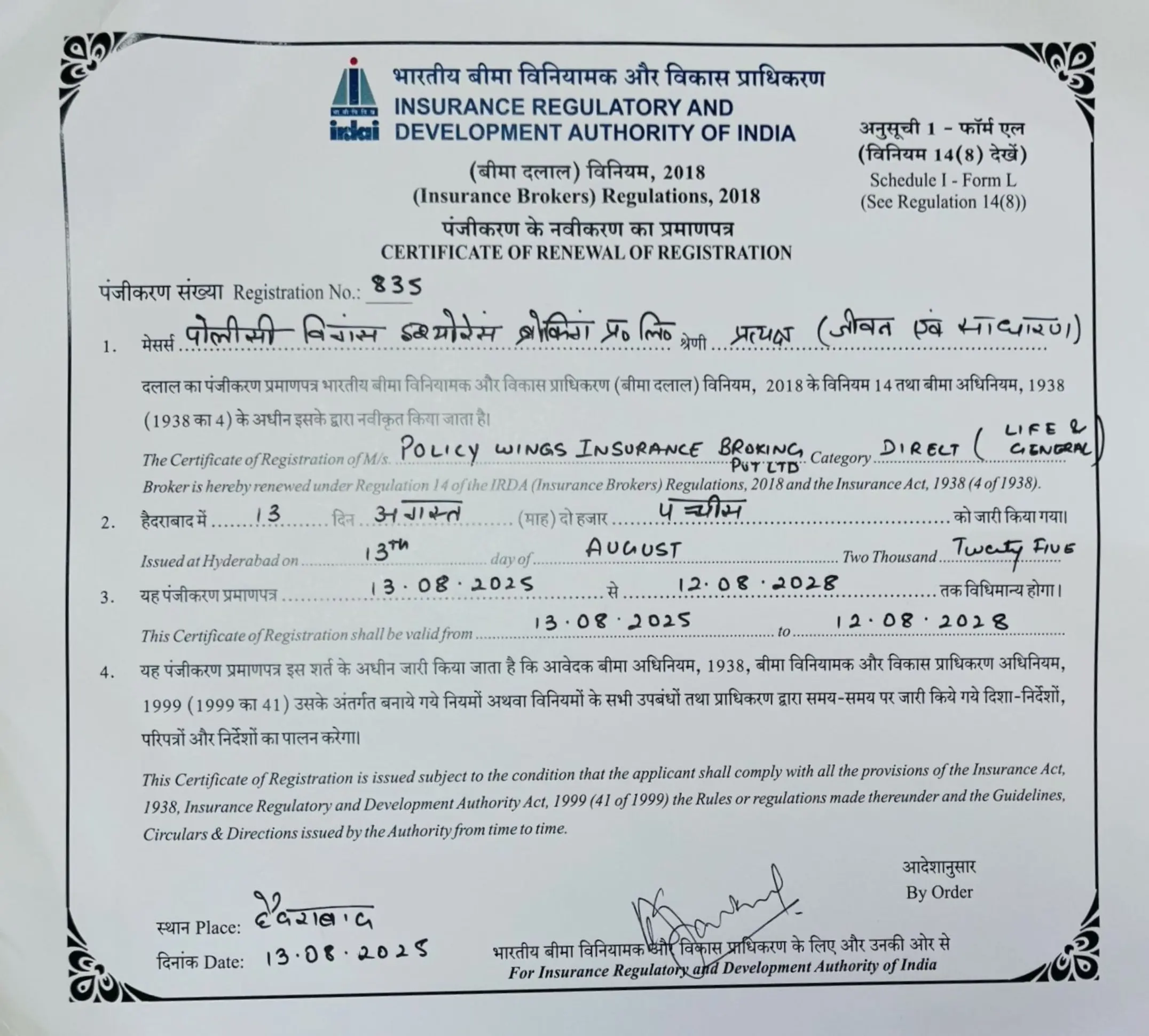Pension Insurance
Pension Insurance
You are earning today and can easily fulfill the needs of yourself and your family. But soon you will be retired, and your needs will also increase with time. How are you going to manage that after your retirement? Savings, right?
But what type of savings?
We would suggest insurance—pension insurance.
Pension insurance will be your post-retirement income. With a pension plan, you can systematically save money over the years so that you can enjoy a steady income after retirement. The pension plan will allow you to be financially independent so that you can deal with inflation.
After all, timely planning is the way to retire on your terms.
Types of Pension insurance

In a deferred pension scheme, you can accumulate a principal through regular premium or single premium payments as per the policy. After the completion of the policy tenure, the pension is given to the insured.

In the immediate annuity scheme, the pension is offered immediately. The policyholder will have to pay a lump-sum amount, and the pension will be provided instantly according to the total amount paid by the policyholder.

In a guaranteed period annuity plan, the annuity is offered to the policyholder for a fixed period like 5/10/15/20 years, regardless of whether or not the insurer survives that duration.

The cover pension plan has a life cover component. After a policyholder’s death, the policy’s beneficiary pays the total amount. The amount is not high, since a maximum part of the premium is paid towards growing the principal rather than covering the life risk.
The government of India launched this initiative. The money invested in the NPS is put into equity and debt funds to generate returns on investment. The insurer can withdraw 60% of the amount at retirement, and the remaining 40% of the amount is used to purchase the pension.

In this particular plan, the pension amount is paid to the annuitant until death. If the option “with the spouse” is chosen, then the pension amount will be transferred to the policyholder’s spouse after the policyholder’s death.

The pension fund is a pension scheme that remains in action for a long period of time. This particular plan offers a better return on maturity and is regulated by the government under the PFRDA.

Under the Whole Life ULIPs pension plan, the money stays invested for the entire life of the insured; after retirement, they can make partial withdrawals to get tax-free income. Withdrawals are allowed whenever needed.

The Plan ensures that you pay a specific amount from your retirement income for life. It is decided on the basis of the pension amount, which is formulated by taking into account your income as well as the number of years you have served with the employer.

In the aforementioned plan, the retirement income isn’t guaranteed, but the contribution is. Within this plan, both you and your employer can contribute. The contributions that you will make will be matched by your employer.

Group pension plans are offered by employers to their employees as a part of their employee benefits package. These plans are designed to provide retirement benefits to a group of individuals within an organization.
Choosing The Best Pension Insurance Plan
While choosing the right pension insurance for yourself, do consider the following points:
- Inflation-adjusted Returns : To determine the best pension plan, you can see if the plan offers inflation-adjusted returns or not. Means the pension fund you choose should provide returns that aren’t affected by inflation after retirement.
- Guarantee Pension For the Spouse : Everyone wishes to live a happy and financially independent retirement life. It is something that you share with a spouse, and you should consider this while selecting a pension plan so that after your untimely demise, the pension is given to your spouse.
- Bonus/Other Benefits : It is advised to assess the plan’s offers and the additional benefits. There are some pension plans that offer a loyalty bonus over time. This will also help you hoard a considerable sum in your retirement fund.
- Guaranteed Income : It doesn’t matter, how much you save throughout your working life, there is always a risk that you will run out of money someday. It is therefore important that you arrange a guaranteed income for life.
Key Features of Pension Insurance
- Steady Flow of Income : Based on how you invest in pension insurance, you will get a fixed income after retirement. So, when you retire, you will be financially self-sufficient.
- Vesting Age : The age at which a pension plan holder begins to receive a monthly pension is known as the vesting age. The majority of pension plans in India have a vesting age of 40 to 50 years. You are free to choose the age between the minimum and maximum limits for when you start earning a monthly pension.
- Surrender Value : It is recommended to surrender a pension plan before the due date, or else you will waive all benefits. You will still get the surrender value of the plan if you have decided to surrender for whatever reason.
- Accumulation Period : The investor can pay the premium as a lump-sum investment or in installments with retirement plans in India. Over time, the wealth would grow in tandem, resulting in a sizable sum.
- Payment Period : It is when you start receiving your pension post-retirement. This means if you are receiving the pension between the ages of 60 and 80, the payout period will be 20 years. Most of the pension plans in India have a distinct payment system. and accumulation period.
Advantages of Pension Plan
- Guaranteed Vesting Benefit : With retirement plans, you will get a fixed/guaranteed income to help you with your retirement.
- Death Benefit : Pension plans also offer death benefits for the financial security of your loved ones in your absence. The policyholder will get the sum assured in case of your untimely demise.
- Flexible-Premium Payment Terms : With a pension plan, you also have the flexibility to select a payment term. You can select the premium payment term based on your financial goals.
- Customize Retirement Plan : You can also customize your retirement plans to help you and your loved ones receive additional protection
- Tax Benefits : Pension plans also qualify for a tax deduction under Section 80CCC of the Income Tax Act, 1961. You can avail of a tax deduction of up to Rs. 1.5 lakh for the purchase or payment made towards the renewal of an existing policy.
Reasons To Buy Pension Insurance in 2025
- You Won’t Be Able to Work Always : You can’t work until the last day of your life. Because of aging and poor health, you have to stop working at some point in your life. But, having a regular source of income is a virtue.
- To Save For Medical Emergencies : The older you get, the more likely you are to develop health issues. Moreover, aging affects not only your health but also your pocket. After retirement, medical expenses are the most frequently occurring expenses.
- To Stay Finally Independent : By being financially independent, you will not become a burden to your children post-retirement. This will also give you and your family a sense of satisfaction.
- You Can Help Your Family : One benefit of retiring gracefully with a pension plan is that you are still able to help out your family whenever they need you.
Top 10 Companies in Pension Plans
- LIC’s New Jeevan Shanti Plan : The LIC Jeevan Shanti Insurance Plan is a non-participatory, non-linked, single premium plan that gives benefits in the form of returns through deferred annuity options.
- HDFC Life Click 2 Retire Plan : The HDFC Life Click 2 Retire Insurance Plan is a unit-linked online insurance that offers market based-returns so that you can meet your post-retirement needs.
- SBI Life Saral Retirement Saver : The aforementioned is a participating, individual, non-linked, savings pension product. The SBI Life Saral Retirement Saver will help the insurer create an income source post-retirement.
- ICICI Pru Easy Retirement Plan : The ICICI Pru Easy Retirement helps you provide a regular source of income through investment opportunities in stocks.
- Max Life Guaranteed Lifetime Income Plan : This particular plan is a traditional pension plan that will help the policyholder create a principal toward a regular income post-retirement.
- Kotak Premier Pension Plan : This plan is available online and is a standard pension plan with various options for individuals looking to secure their retirement.
- Bajaj Allianz Lifelong Goal : It is a unit-linked, whole-life insurance policy that helps in creating a savings corpus and earning income till the age of 99
- ABSLI Empower Pension Plan : It is the Aditya Birla Sun Life Empower Pension, it is unit-linked and it is a non-participating pension plan.
- TATA AIA Life Insurance Guaranteed Monthly Income Plan : This is the guaranteed monthly income plan offered by TATA AIA and is a non-participating, non-linked, individual life insurance savings option.
- IndiaFirst Life Guaranteed Annuity Plan : This is a deferred Life Annuity plan under which the policyholder can pay a single premium and receive lifelong benefits. This plan gives you 12 different annuity options to choose from as per your needs.
If you are the sole earner in your family, you have certain debt obligations to fulfill, or your kid’s education demands heavy investment, the pension amount should be more than all your potential expenses combined. Simply put, if you see financial security as a crucial part of your future, you should start your retirement planning now and invest in a pension plan. Now you know what pension means and how it functions. It ensures financial security in your retirement years, helping you live a happy and fulfilling retirement life.
It’s time to get pension insurance.
Leading Life Insurance Companies
Latest Blogs
Your team is the backbone of your company that must be taken care of. Their health directly impacts your success and that’s why you must offer group health insurance for employees. It protects them in medical emergencies and also shows that you really value their well-being. A good salary is not enough. To retain your employees in this competitive market, you must offer solid health insurance in India to be an employee-friendly workplace. However, choosing the right policy is not so easy and picking the first plan you see is never recommended. Employers need to know what really matters, carefully evaluate different health insurance plans and then finalize one. A wrong choice can lead to dissatisfied employees. But don’t worry, because we are here to help you! 5 Things to Check in Group Health Insurance It’s very good if you are considering buying a group insurance but before you go ahead to sign the document, you should always check for these points: Coverage That Matches Employee Needs The first step would obviously be to understand your employees and what are their healthcare requirements. If you have a team of young professionals, they would mostly need basic hospitalization coverage. But, for an older workforce, you must consider higher coverage because there may be lifestyle-related illnesses. Make sure the policy takes care of the basic/common needs like consultation visits, hospital stays, maternity etc The policies that also include pre-existing diseases are even better because individual plans often exclude them. There should also be an option to extend coverage to the families of the employees. The best group health insurance for employees would always be the one that adapts to the actual needs of your team and not just offers generic protection. Size of the Hospital Network Another highly valuable feature of health insurance in India would be a wide hospital network. This is because, through this, your employees will be able to get treatment from their nearest hospital instead of worrying about arranging cash. Shortlist from those plans that provide cashless hospitalization across a large number of hospitals in places where your employees live and are accessible to them. Also, check if the insurance company has partnered with reputed hospitals because that ensures faster and smoother claim settlement. This might be a small detail but it can actually make a big difference when there is an emergency situation. Premium Costs vs. Benefits Offered Cost matters and so does value for money. You have to compare the amount with what’s being offered. Often, the cheapest plan looks the most attractive but it’s not if the benefits are not enough. Similarly, why should you pay for those features that employees won’t even use? Compare multiple health insurance plans and select the one that gives the best value for money. There must be an option for add-ons like maternity and dental because employees really value these benefits. You must also ask about co-payment clauses, deductibles or hidden limits since they majorly affect claims. The ultimate goal is to provide employees with strong coverage without shaking the company’s budget. Claim Settlement Ratio and Process At the end of the day, it’s actually the claim settlement of the policy that makes it good or not good. There’s absolutely no point in getting insurance if your employees have to struggle during claims. The claim settlement ratio (CSR) of the insurer says a lot. A high CSR is a positive indicator. It tells that the company settles most of its claims without any stress. If the process is quick and cashless and employees don’t have to handle too much paperwork, it’s a green signal. There’s nothing like having a dedicated relationship manager or support team by your side while you are handling group claims. Only if there’s a smooth claim experience, employees will have more trust in both the employer and the insurance company. Flexibility and Add-On Options Every company has a different workforce and that’s why there should be flexibility in health insurance plans. Confirm if the policy allows employees to opt for voluntary add-ons by paying extra. Business aims to grow. The policy should also allow easy scaling up. Look for features like employees really appreciate like health check-ups and mental health support. All of these will make your team will feel they are valued and genuinely cared for. How Group Health Insurance is Different from Individual Policies Usually, when employers are exploring health insurance in India, they have one question in mind: why choose group health insurance for employees when they can buy their own policies by themselves? The fact that both insurance policies are so different makes group cover a requirement. Here’s a compare the two options on the basis of different factors: Coverage Start: Group Health Insurance: The coverage starts as soon as you get the policy. No waiting period for pre-existing diseases. Individual Health Insurance: There’s often a waiting period of 2–4 years for covering any pre-existing conditions. Cost: Group Plans: It is more affordable since premiums are calculated for the whole group and are negotiated by the employer. Individual Plans: There are higher premiums because the risk is separately calculated for one person/family. Flexibility: Group Plans: While the coverage is decided by the employers, employees might also get the option to top up. Individual Plans: You have full flexibility to choose coverage, add-ons and even the insurance company. Ease of Management: Group Plans: The whole paperwork, renewals and claims support is to be handled by the employer. Individual Plans: Employees only will have to manage each and everything by themselves. Value for Employees: Group Plans: Because they offer a quick process and good coverage, it shows the employers care for their teams. Individual Plans: While they are perfect for long-term security, the cost is higher and gets more restrictive in the short run. When you get group health insurance for employees, it becomes your safety net and ensures the team is never left unprotected, right from the first day.
...Introduction Damage to property can be a huge loss. We need reliable property insurance to protect our home, workplace or any other valuable property against uncertainties. It’s certainly a must-have. But there are just so many different property insurance plans out there. Each insurance company makes the same promise. They claim to offer affordable premiums, extensive coverage and quick & easy claim settlements. With so many options, how do you know which one is actually the one for you? Comparing property insurance quotes is very important; it’s just like comparing prices before buying a gadget or maybe a bike. Only by analysing multiple insurance quotes can you find the perfect option that offers value for money. Why Property Insurance Matters Buying a property, whether a home or a place of work, means making one of the biggest investments. Any kind of damage to it due to fire, theft, accident or even a natural disaster leads to a huge financial loss that can only be covered with a property insurance policy. The right property insurance plans in place will: Protect your property from damaging natural disasters. Cover losses that may happen due to fire or explosions on the premises. Get protection for the loss in case of robbery. Stay protected in case of accidental damage. Continue with the business if it was a commercial property. Getting a property insurance plan gives you assurance that you won’t have to face the entire financial burden alone in case of an unexpected mishap. What Are Property Insurance Quotes? When you reach out to an insurance company to buy a policy, they give you a cost estimate for the kind of coverage you’re seeking. This is called a property insurance quote and it includes various information like: The premium: How much you will have to pay and the frequency (monthly, quarterly or annually). The coverage details: What all risks are covered and the maximum amount that’ll be received. The deductibles: How much would you have to pay from your pocket before the insurance comes into the picture. All the detailed terms and conditions of the insurance policy. Upon comparing property insurance quotes, you not only see the difference in the prices but also what you will actually pay for. Why It’s Important to Compare Property Insurance Quotes? Would you ever buy the car you see in the showroom without checking a few more? You won’t! And the same behaviour should be for insurance. Here’s why you must compare: Save Money– Different companies offer similar coverage but premiums may differ. When you compare, you can get the most cost-effective deal. Understand Coverage– Not all property insurance plans available will cover the same set of risks. For example, some companies just don’t include natural disasters. Avoid Surprises– Reading the details carefully helps you know what’s included and what’s not and hence, no shocks later during claims. Tailor to Needs– By comparing, you choose the correct plan for your property type, whether it’s residential, commercial, rental, etc. Best Ways to Compare Property Insurance Quotes Now comes the main part! How exactly should you compare quotes so that you end up making a smart decision? Look Beyond the Premium While it’s normal to check the price as the first thing, it’s not a good idea to get swayed by the cheapest property insurance quotes. A low premium often means either that the coverage is limited or the deductibles are high. Let’s say you might find one policy at ₹7,000 per year and the other one at ₹11,500. The catch is that the cheaper one doesn’t cover natural disasters, while the expensive one does. Hence, you get better value in the second one. Check the Coverage in Detail Not all property insurance plans will protect you against the same set of risks. The coverage should match your property type and location risks. So, make sure that all this is included: Damage due to fire and accident Natural calamities cover Theft or burglary Electrical or mechanical breakdown Third-party liability (you causing damage to another person’s property) Understand Deductibles Basically, a deductible is the amount you agree to pay before insurance kicks in and lower premiums usually have higher deductibles. When comparing property insurance quotes, don’t miss out on this point. Say your policy has a ₹40,000 deductible. So if your damage is ₹65,000 then the insurance will only cover ₹25,000. Compare Claim Settlement Ratios Getting a property insurance plan is only useful if the company doesn’t make a fuss while settling claims. You must check the claim settlement ratio of the insurer and learn how many claims they actually take action on. Even if the premium is slightly higher, go for a trusted insurer because a cheap plan might delay payments. Look for Add-Ons and Benefits Some insurers offer extra features. Adding them may slightly increase your premium but then the protection also becomes wider. You can consider: Rent loss cover: If you live in a rented house and it becomes unlivable after damage, the policy will help. Coverage for valuable contents inside the property: It provides coverage for jewelry, expensive appliances, etc. Temporary accommodation expenses: In case you can’t stay in your home after damage, that will be taken care of. Compare Policy Terms and Exclusions Always read the fine print because you might assume some coverage when it might not be there. Like some plans don’t include damages caused by negligence or damages from gradual wear and tear. And when you carefully compare property insurance quotes, you’ll know exactly what you’re getting. Check Flexibility of Payment Plans Some insurers allow you to pay premiums at your preferred duration. Monthly, quarterly or annually; you choose. You can always pick what fits your budget and which option helps you save more over time. Monthly vs Annual Premiums – Which is Better? When you have a bunch of property insurance quotes with you, you’ll notice that there is also an option of paying monthly or annual premiums. Here’s the difference:
...Introduction If you look at it, retirement is actually the best time for traveling the world. It could be a religious tour, visiting your children abroad or exploring your dream destinations. But sadly, issues like medical emergencies, flight delays or other unexpected situations can happen any time. This makes the trip so stressful. In such situations, travel insurance comes in really handy. Only the right insurance can bring the much-needed relief to seniors. So, what should you look for when choosing travel insurance plans? We’ll find out in this guide to travel insurance for senior citizens Why the Need for Senior Citizens Travel Insurance? Health concerns and travel risks naturally increase with age. One minor illness and there can be big expenses in a foreign land. Thankfully, travel insurance protects you from such unexpected expenses because it includes: Medical emergencies: It takes care of the hospitalization, treatments, doctor fees etc. Trip delay or cancellation: The policy compensates you for prepaid and non-refundable expenses like hotel bookings or connecting flights. Loss of baggage or documents: Your insurer covers for the essentials that you have to buy if your luggage is delayed or lost. Emergency return: Helps in immediate return to your home country due to a genuine emergency like a medical problem. Personal accident coverage: Gives the required financial support if there’s accidental injury, disability or death. With travel insurance plan in place, seniors don’t have to worry about the unexpected and can fully enjoy with peace of mind. Selecting the Right Senior-Friendly Travel Insurance Older people definitely need travel insurance. It will help them all the way to navigate uncertainties, whenever they arise. Here’s what makes a plan the most helpful while traveling: Age Limit and Eligibility The first thing you check is the eligible age because most insurance providers offer different plans for different age groups. A lot of travel insurance plans cover 60 or 65 year old people. Some senior citizen plans often cover those up to even 85 years. Be attentive here and choose a policy that clearly mentions what is covered for your particular age group. Buying a generic plan won’t make sense because it’s meant for younger travelers and won’t offer the same support that seniors need. Comprehensive Medical Coverage Medical costs abroad can be extremely high in another country and when you are a senior with pre-existing conditions, the total bill will really upset you. Hence, make sure your travel insurance provides: High medical coverage limits: It should be enough to cover hospital stays and treatments where you are going. Coverage for pre-existing diseases: Some plans also cover existing health issues related emergencies. Cashless hospitalization options: You get this benefit at the hospitals that are in the list. Emergency medical evacuation and repatriation: It really helps in case you need to be brought back home. Be honest while buying the policy. Disclose your medical history because if you hide pre-existing conditions, your claim will be rejected. Coverage for Trip Cancellation and Delay Senior citizens might travel for family functions, religious trips or any other purpose. Now, any last minute situations can be a big bummer causing a lot of stress. A good travel insurance plan ensures that a sudden problem doesn’t cause panic or lead to unnecessary expenses. Hence, it should cover: Trip cancellation: You will be refunded for prepaid bookings if at all the trip gets cancelled due to illness, accident or other valid reason. Trip delay: If the flight gets delayed beyond the mentioned duration, your accommodation and meals will be handled. Disrupted Trip: Required support is given to help you return home early for emergencies. Coverage for Pre-Existing Diseases One of the most meaningful benefits for senior citizens! Many insurers don’t provide this feature and some provide coverage only in life-threatening emergencies. Therefore, when buying travel insurance, do check: If the plan covers your pre-existing illnesses. If yes, see when the coverage actually applies (is it valid only for emergencies or limited payouts). Whether your medical history should be informed through a full health check-up or a form. For older travelers, the plans should at least provide partial coverage for pre-existing illnesses. Cashless Hospital Network When you are in another country, handling payments during an emergency can be a major stress. This is where cashless medical treatment comes to the rescue. If your insurance company has a global hospital network, nothing like it! In this case, all the bills are settled directly between the insurer and the hospital. This saves a lot of time and also the stress of currency exchange. Senior citizens can’t take care of this alone. 24×7 Customer Support Emergencies call for quick assistance. A travel insurance provider that offers 24×7 support would be of great help, especially with international toll-free numbers. It shouldn’t be difficult to reach the insurer for: Medical emergencies Assistance with a lost passport Flight issues Guidance on claim When you know that support is just a phone call away, you stay more confident in a foreign land. Coverage for Personal Accident and Luggage Loss Everyone hopes and prays that they don’t face any mishaps. One bad situation and there can be so much inconvenience. This is why these benefits should ideally be included in the travel insurance plans for seniors: Loss of baggage: Reimbursement for the missing items. Delay of baggage: Compensation for the purchase of essential items during the delay. Personal accident cover: It provides compensation in case of injury or death by accident during the trip. Easy Claim Process The travel insurance with a simple claim process is good to go. After all, senior citizens may get really overwhelmed with complicated paperwork or websites. Look for insurance companies that offer: Easy online claim submission Dedicated helpline for quick assistance Requirement of minimum documentation When the claim process is not complicated, seniors can get the required support just in time. Compare Different Travel Insurance Plans There are many travel insurance plans out there and they differ in various aspects.
...Planning for the future takes a different route in your retirement years. Paychecks may not be there but responsibilities are. Parents keep worrying, thinking, “What will happen to my family if something happens to me?” That’s exactly where term insurance has your back. Term insurance for parents not just covers risks but also makes sure your family continues to stay financially stable after you. Also, a reliable term insurance plan makes it easy to cope with the rising medical costs. The good news is that today, in 2025, many insurance providers in India are offering specially designed, simpler and smarter term insurance plans for senior citizens. Wondering which ones are worth considering? Let’s look at the top plans! What Is Term Insurance for Senior Citizens? It’s an insurance policy that provides the necessary financial protection to your family if unfortunately, something happens to you during the policy period. It doesn’t offer any returns or bonuses. Instead, it ensures your loved ones get a fixed payout in case you are no more. Now, the term insurance for senior citizens has the same concept but just a few changes: The eligibility age in some plans is now up to 70–75 years. It’s usually mandatory to get the medical check-ups. The increased age and health risks make the premium higher. At the end, the primary goal is to provide peace of mind that your dependents won’t face financial struggles after you. Why Should Seniors Consider Term Insurance? If you think insurance is only for the young, it’s not true. In real life, there are many responsibilities even after 60. You might have family members who are totally dependent on you, there may be unpaid loans or you simply want to leave behind a financial safety. Buying term insurance for parents or senior citizens makes a lot of sense because: Protecting the Dependents– The payout amount can be used by your spouse, children, or even grandchildren to manage their regular living expenses. Debt Coverage– If you have any home or personal loans going on, the insurance would really help your family in paying the EMIs. Legacy Planning– A term plan is a wonderful way to leave financial support for your loved ones when you’re no longer around. Peace of Mind– The fact that your family won’t face sudden financial issues lets you peacefully enjoy the retirement phase. What to Know Before Buying a Term Insurance Plan Before you finalize a plan, you must have an understanding of how term insurance plans for senior citizens work. Entry Age– Most insurance companies allow the entry of new policyholders up to the age of 65 or 70. In fact, a few extend it to 75. Coverage Period– According to your entry age, some plans ensure coverage up to 80, 90, or even 100 years. Medical Tests– You can always expect to get complete health checkups because it’s extremely important to be transparent about your medical history. Premiums– What you pay will certainly be higher than that for younger applicants. However, the peace of mind it offers is worth it. Claim Settlement Ratio–It’s highly recommended to choose a company that is well-known for fast and reliable claim settlements. Top Term Insurance Plans for Senior Citizens in 2025 As of 2025, here are some of the most trusted term insurance plans for senior citizens in India: Tata AIA Sampoorna Raksha Supreme This wonderful plan provides life cover up to the age of 100 years, along with flexible payout options. Whether you want to give your nominee a lump sum, a regular income or even both, it’s totally up to you. The solid claim settlement record of the company makes it a strong pick for seniors. ICICI Prudential iProtect Smart Allowing coverage up to 85 years of age, it also includes adding optional riders like critical illness and accidental death benefit. ICICI also runs online discounts for non-smokers and women applicants so do explore them. HDFC Life Click 2 Protect Super It is a very popular option for older buyers. This plan from HDFC offers multiple benefit options. There is “Life Protect” (which is the basic term plan) and “Income Plus” (which combines both lump sum & monthly income payouts). Kotak e-Term Plan This digital term plan from Kotak Life covers individuals up to the age of 75 years. You can rely on it for affordable premiums and an easy online purchase. Also, the documentation is quite minimal. PNB MetLife Mera Term Plan Plus The senior citizens who want flexibility can totally go with this plan. In this, you can either pick a life cover up to 99 years or even a shorter policy term as per your needs. Moreover, the company also offers joint-life options for couples so you can consider them. SBI Life eShield Next SBI, one of the most trusted names in insurance, offers this term plan that covers you till you’re 85 years old. Its flexible premium payment terms and add on for critical illnesses make it so popular. You can trust these insurers for their good claim settlement history. They even offer online tools to quickly calculate the premium amount. However, before you go on with a plan, do pay attention to the eligibility criteria and your current health conditions. Choosing the Right Term Insurance Plan Comparing different options might confuse you. Here is how you can pick the most suitable term insurance plan: Start with Your Age & Health: Since your eligibility & premium heavily depend on these two factors, you must get a full medical checkup before applying. Decide the Coverage Amount: The payout has to be enough to cover the needs, debts and other expenses of your dependents. Compare Premiums Online: Go to trusted websites to get quotes so you can compare and see which policy fits your budget the best. Check Payout Options: Would your family prefer a one-time lump sum or a regular monthly income after you? This needs to be decided before. Check Claim History: It’s
...Travelling through the later years of life, everyone seeks comfort, peace and good health. It’s actually the best time to enjoy life because now you have worked enough. However, getting older also means more doctor visits. Medical costs are rising every year and a single hospital bill can drain your savings. That makes Senior Citizen Health Insurance a must-have for older citizens. These health insurance plans are specially designed to handle higher medical needs so that seniors don’t have to worry about expenses. This blog contains some of the best health insurance policy for seniors available in India right now so you can compare them and make the right choice. What to Look for in a Senior Citizen Health Insurance Plan Before getting on to the different insurance for senior citizens, let’s first understand the key features that actually matter when buying. Here what you should pay attention to: Entry Age & Renewability: Check how old you have to be to buy the policy and whether there’s an option for lifetime renewal. Sum Insured: The higher the coverage amount is, the better, because it even covers the big medical expenses. Waiting Period for Pre-Existing Diseases: Find out how long you are supposed to wait before the coverage starts for existing health conditions. Co-Payment: Some policies require you to pay a certain part of the bill, so find out about your share. Room Rent & Hospital Network: A plan that offers a wide cashless hospital network is always beneficial. Also, there must not be many restrictions on room type. Additional Benefits: Presence of free health check-ups, ambulance, daycare etc is always a plus. Top 5 Senior Citizen Health Insurance Plans in India With so many choices available, it’s obviously tough to find ‘that one’ right policy. Here are 5 popular and trusted health insurance plans in India that are very thoughtfully designed to meet the needs of senior citizens in India: Star Health – Senior Citizens Red Carpet Policy Entry Age: 60–75 years old Coverage Amount: ₹1 lakh starting and goes to ₹25 lakhs Highlights: Only after one year the existing illnesses get covered. Modern daycare treatments and cashless hospitalization are included. Option for lifetime renewal available. Why it’s good: The fact that it’s one of those few plans that start covering existing diseases very quickly makes it a solid choice for seniors who have medical histories. Care Health – Care Senior Health Advantage Plan Entry Age: 61 years and more Coverage Amount: From ₹3 lakh and then up to ₹10 lakh or even higher Highlights: Annual health check-up is free. Ambulance charges, home treatment and even AYUSH therapies are all included. There’s no upper age limit to apply for it. Why it’s good: Since this plan offers flexibility and broad coverage, it comes across as an ideal plan. It’s certainly good for those who seek overall protection with fewer restrictions. Bajaj Allianz – Silver Health Plan Entry Age: 46–70 years Coverage Amount: Depending on the variant, it ranges between ₹50,000 and ₹10 lakh Highlights: Coverage for the pre-existing illnesses get started after the given waiting period. Cashless treatment network spread across India. You get an accumulative bonus for all the years you didn’t make a claim. Why it’s good: Being affordable and well-balanced, it is highly suitable for seniors who want the basic coverage without having to pay high premiums. Niva Bupa – Senior First Plan Entry Age: 60–75 years Coverage Amount: Goes up to ₹25 lakh Highlights: Coverage amount is restored after a claim. Modern treatments and advanced procedures are covered. Offers an impressively large network of cashless hospitals. Why it’s good: Older citizens who are interested in higher coverage limits and flexible treatment options can go for it. Aditya Birla – Activ Care Plan Entry Age: 55–80 years old Coverage Amount: ₹3 lakh and above Highlights: More than 500 daycare procedures are covered in it. Home treatment benefits are provided. Free annual health check-up is also included. Why it’s good: The combined benefit of affordability and wide coverage makes it one of the most preferred plans for senior citizen health insurance. How to Choose the Right Plan Choosing the best health insurance policy for seniors isn’t just about a single major aspect. It depends on several factors like the health condition, age and budget of the policyholder. While the right plan should provide adequate coverage, it should also be easy to make a claim when needed. Here we have a few simple yet essential tips that you need to follow to be able to make the correct decision: A plan that offers lifetime renewability: Medical needs become more frequent with growing age. The renewability factor will make sure that you continue to get the desired coverage even in your later years. Shorter waiting periods: If you have pre-existing health concerns, your policy shouldn’t have longer waiting periods. It should start the coverage for your existing illness sooner. Check the hospital near your home: The network hospitals must also be near you for smooth access and easy cashless claims. If the network of hospitals is wide enough, the treatment becomes a lot more affordable and convenient. The co-payment clause: You must have a proper understanding of how much you might be required to pay from your pocket when you are making the claim. Not just the cheapest plan: Don’t just look at the price but rather consider the plan that offers the best overall value. There should be sufficient coverage, practical benefits and an easy claim process. Remember, don’t stress a lot just on saving money but ensure peace of mind and reliable protection for the years to come. Conclusion Buying a reliable Senior Citizen Health Insurance plan means investing in your health and securing peace of mind. It should provide you with financial safety when you need it most so that there is no compromise on quality care. Since every senior has different health needs, take your time to compare the policies on what they
...Introduction It might have happened to you or somebody you know that for years you had your mediclaim insurance policy and you were also paying regular premiums. Once time you made a claim and found out that certain benefits had lapsed. So frustrating, isn’t it? This is why it’s highly recommended that when you renew your mediclaim insurance, you must also make sure your coverage will continue to fit your needs. It’s super important to review your policy at the time of renewal, especially because medical costs are increasing. Let’s discuss what all do you need to check before renewing your mediclaim insurance in India so that you don’t miss changes in coverage or lose important benefits. What Makes Renewal So Important? Life is never the same. Sometimes situations change, sometimes lifestyle. You could develop a new illness, there could be an increase in medical prices or maybe the needs of your family grow than before. You must never renew your policy without reviewing it. When you pay attention at that time, you ensure having the right coverage when you actually need it. You can’t do much once you have bought the policy but renewals offer you a chance to: Upgrade coverage and match it with the rising medical costs. Add new riders or benefits to the policy that were not there before. Always renew on time so that waiting periods don’t restart. Protect your coverage by staying regular with your payments. After all, a careful renewal is a guarantee that your mediclaim insurance policy grows with your changing needs. What to Check Before Renewing Your Mediclaim Policy? Renewing your mediclaim insurance policy doesn’t just mean paying the premium on time but ensuring your coverage is enough for you when required. Let’s see what you should definitely check at the time of policy renewal: Coverage Amount (Sum Insured) In India, medical costs are rising every year and this is a point of concern. The insured amount you chose a few years ago is most possibly not enough today, especially if you’re in a metro city. Check if you need to increase the coverage while you are renewing. Waiting Periods for Pre-Existing Diseases When you keep renewing the policy, the waiting period for pre-existing conditions also keeps reducing and it’s a big benefit. At the time of payment, confirm whether the mediclaim insurance policy cover those diseases now. Room Rent Limit and Hospital Network Room rent limits or hospital tie-ups might be small factors but can affect your claim big time. If you want a private room but your policy allows only a shared room, you may have to pay yourself. It should also be checked if your preferred hospitals are a part of the insurer’s network. New Riders or Add-On Benefits Many insurers introduce new features for the convenience and benefits of the policyholders. People can always opt for the extras like critical illness riders, maternity cover etc. Of course, renewal time is the best to add these riders to your mediclaim insurance. Premium vs. Benefits The premium you’re paying should ideally justify the benefits you’re getting. It’s possible that there’s another plan from the same insurer or a different one that offers better coverage at a similar cost. At renewal, you upgrade your policy and it continues the same. No-Claim Bonus (NCB) Your insurer should also offer a no-claim bonus. Basically, many insurance companies increase your coverage amount for the year you don’t make a claim. Do keep this benefit in mind while renewing. Exclusions and Policy Updates Insurance companies also keep updating their terms. Every time you renew, go through the fine print to check what’s not included this year. It could be procedures like cosmetic surgeries or certain advanced treatments, so stay alert and informed. Grace Period for Renewal Renewal of mediclaim insurance in India has to be done before the due date. While insurance companies normally provide a grace period of 15–30 days for payments, you can’t make claims during this period. Also, missed renewal means waiting periods would restart and all the previous time has been wasted. Mistakes People Make During Renewal Renewing a mediclaim insurance policy isn’t limited to continuing the same plan. There are mistakes that so many people unknowingly make that either affect their coverage or claims. Just beware of these catches for a wise renewal: Not updating health details– Don’t forget to inform your insurer if you’ve developed a new illness or undergone surgery because hiding details can lead to your claim being rejected. Missing the due date– A late renewal means you will missout on your No Claim Bonus (NCB) and even a policy lapse. Ignoring changes in coverage– Sometimes insurance company change their terms, add new rider options or modify coverage so go through the fine print. Accepting higher premiums blindly– Many people pick up the first policy they see. Not comparing alternatives, they end up paying more. How to Save on Your Mediclaim Insurance? Time for renewal? It’s the perfect chance to make your mediclaim insurance in India more cost-effective while holding on to the benefits. All you need is a little planning for a reduced premium and improved coverage. Consider portability– If you find that another insurer is offering better benefits at the same cost, you can switch to it. Your continuity benefits will remain the same. Opt for long-term policies– Many insurers will also offer you discounts if you straightaway buy a 2–3 year mediclaim policy instead of renewing it every year. Adjust deductibles wisely– If your employer already provides health cover, choose a bigger deductible on your mediclaim to lower your premium. Compare online before renewal– You can also benefit from the market competition. You must check different plans so you can get the best value for your money. The Rising Need for Mediclaim Insurance in India The costs of healthcare in India are skyrocketing and there are hardly any signs of slowing down. Treatments for critical conditions like cancer,
...Introduction Let’s be honest, don’t we all picture ourselves relaxing in our home and planning our next vacation in our retirement years? After so many years of working hard, this is the only ideal case. However, this ‘dreamy’ retirement calls for smart planning. You can secure your future by putting aside small amounts in your 20s, controlling expenses in your 30s or even by catching up in your 40s. Getting a retirement insurance plan is something your future self will thank you for. It provides income after you stop working, protects your family and also covers rising medical costs. From regular saving to choosing the right retirement insurance for seniors, it’s not about getting late but getting started. Here we will talk about how you can start planning for a stress-free retirement at your current age. Why Retirement Planning Matters at Every Age Most people assume retirement planning is only for seniors who should be taken care of in their 50s or 60s. But actually, insurance for retirement is a years-long process that should ideally begin the moment you start earning. Basically, the earlier you start, the more you benefit you get out of it. The small contributions compound into a solid sum. Even if you start later, like in the middle age, you can still catch up with stronger and more strategic investments. A well-chosen retirement insurance plan helps you build a good amount of savings, provides a steady income stream when you decide to stop working and gives you the peace of mind you need after all these decades of grinding. Planning for Retirement in Your 20s 20s is the age when we are often exploring career growth and experiencing life. Though not everyone is financially stable, we all can start with a little amount of disciplined saving can create because even that’ll turn into huge retirement fund years later. Start small but consistent: Stay regular even if you’re contributing a little amount. You will be delighted to see how your savings multiply over decades. Invest in growth-focused options: High growth potential options like equity mutual funds, SIPs and long-term investment tools are also a smart move. Secure with a retirement insurance plan: When investments come with insurance, your financial future is strongly protected from unforeseen events. Even if you could spare just ₹5,000 per month in your 20s and let it accumulate till your retirement, you will have a wonderful sum with you; even better than starting in your 30s with the same amount. Planning for Retirement in Your 30s When most of us are in our 30s, we have more responsibilities like home loans, children’s education or other family expenses and our budget often feels tighter. However, it’s still a good time to start building your retirement fund. Balance growth and safety: A part of your savings can go to bonds and some part to growth investments, as both will grow your money. Top up your contributions: As income rises every year, you can also increase your savings amount. Choose a secure insurance for retirement: Some policies are particularly designed for long-term savings. Besides giving life cover to protect your family, they also help you build a secure retirement fund. It’s ok if you couldn’t start in your 20s because starting in your 30s will also give you enough time to build a strong financial base for your retirement. Planning for Retirement in Your 40s Now, your 40s are a critical stage because retirement is not so far away. This is the high time when you must take retirement savings seriously and close compensate as much as possible for the past years. Retirement savings above lifestyle spending: Now you have around 15–20 years left to grow your funds (which is not much) so stay consistent. Choose safer and stable plans: Maintain a balance and focus more on secure yet low-risk options like fixed deposits or government-backed schemes. A retirement insurance plan: You need the right policy at this stage to protect your savings and offer guaranteed returns so you can have a stress-free retirement. Think long-term health costs: Medical expenses only go up with age and a reliable insurance for retirement policy will help cover these expenses. By your mid-40s, you must explore retirement insurance for seniors. It focuses on providing a secure and steady income and medical coverage after the age of 60. Why Retirement Insurance Plans Are Essential Regular savings or investments won’t be enough to cover your retirement needs. There will be inflation, unexpected emergencies and skyrocketing healthcare costs. A retirement insurance plan will accumulate to be a handsome amount, protect you and your family from unexpected situations and enable you to live your retirement with dignity and independence. Regular income after retirement– You will have an assured income even when you are no longer working. It will be easy to maintain your lifestyle and enjoy your retirement years instead of worrying about expenses. Financial security for family– In case of an unfortunate event, the money from these plans will save your loved ones. Your family will be able to manage daily expenses, loans or long-term goals. Health coverage– You retire in your 60s when medical expenses are one of the biggest concerns. Many retirement insurance plans also include health coverage that reduces the burden of heavy bills. You can access proper treatment without exhausting your savings. Flexibility for all age groups– Whether you have just started working in your 20s, planning seriously for retirement in your 40s or even looking for retirement insurance for seniors, there are different options available to choose from. Starting early collects more money, while starting later is better than never. Retirement Planning Mistakes to be Avoided Many people unintentionally make mistakes that can harm their retirement fund. Here’s what you should avoid to save a lot of trouble later: Starting too late– The later you start (40s or 50s), the more you lose on your compounded amount. All those small contributions in your
...Introduction Accidents can happen to anyone, anytime and even to the most careful drivers. It could be a small scratch or a major car crash; it is not hard to deal with it. But in such times, having third party liability insurance helps big time. However, many people aren’t sure of how exactly to make a claim, what to do and what to avoid. If you are also on the same boat, don’t worry! This quick guide will tell you what third party insurance covers and how you can file a claim after an accident. What is Third-Party Insurance? Before we discuss the claim process, let’s understand what it is. Basically, third party insurance is a compulsory form of motor insurance in India and all drivers need to have it. If at all your vehicle causes damage to another person, their vehicle or property, this plan will be your financial protection. Here, the “third party” is anyone who is affected by your vehicle in an accident, except you or your insurance company. Your third party liability insurance policy will pay for: Injury or death of another person because of your vehicle. Damage to the property of third-party like a car, scooter, wall, fence etc However, you must know and remember that insurance for third party liability will never cover any damages to your own vehicle or injuries that are caused to you. If you want complete coverage, a comprehensive policy is what you need When Can You Claim Third-Party Insurance? A third party insurance claim can be made in these situations: If physical injury or death is caused to another person in an accident. If your vehicle has caused damage to someone else’s property or vehicle. For example, if your car hits another vehicle, then your third party liability insurance will cover the repair cost. Or maybe for covering medical or legal compensation if a pedestrian gets injured. Step-by-Step Process to Claim Third-Party Insurance You need to follow a few steps for filing a third party liability insurance policy claim. Let’s go through them: Step 1: Inform Your Insurance Company Immediately Without wasting any time, the first thing you should do after an accident is inform your insurance company. This better be done within 24 hours because delays might weaken your claim. You can go to their helpline or mobile app and quickly report the accident. Provide them with important details like: Date, time and accident location Describe exactly what happened Inform about the vehicles and people that were involved Step 2: File an FIR at the Nearest Police Station Go right away to file an FIR (First Information Report), especially if there’s an injury, death or major damage to property, because without it, your third party insurance claim might be rejected. Reach the nearest police station and explain what happened in detail. Don’t miss mentioning all vehicles and people involved. Do keep a copy of the FIR to be used during the insurance claim. Step 3: Collect Evidence from the Accident Site Having proper evidence makes your claim stronger. All these details will help your insurer to evaluate the whole situation and process your claim faster: Take photos or record videos of the damaged vehicle and the overall accident scene. Note the registration number of the vehicle, details of the driver’s license and even contact information of the witness, if there are any. Step 4: Register the Case with the Motor Accident Claims Tribunal (MACT) Basically, the insurer doesn’t directly settle the third party liability insurance. It’s handled through the Motor Accident Claims Tribunal (MACT). This is a legal body that ensures that both the vehicle owner and the affected party are treated with fairness. Here’s how it works: The affected third party files a claim with MACT. MACT reviews the case from both parties and decides the compensation amount. Your insurer then pays you as per the tribunal’s decision. Step 5: Submit the Required Documents You will need to submit certain documents to process your insurance for third party liability claim. Have these documents ready to avoid settlement delays: Copy of your insurance policy FIR Copy Driving licence of the person who was driving Vehicle’s registration Certificate (RC) Photos of the damaged vehicles and the accident area Any notice from court or MACT (if applicable) Step 6: Cooperate During the Investigation Your insurance company may also appoint an investigator on the case. They will inspect the damages and verify the details of the incident. Here, you need to give your full cooperation. Provide them with honest information and access to your vehicle. This keeps the process transparent and helps your insurer smoothly settle the claim. Step 7: Tribunal Decision and Claim Settlement Once the MACT reviews all details, the compensation amount to be paid is decided. After that, your third party liability insurance policy will cover this compensation. The amount will be paid directly to the third party and not to you. Checklist of Documents Required for Third-Party Insurance Claims Make sure you don’t miss anything from the following: Copy of third party insurance policy Copy of FIR Driving licence RC of the Vehicle Photos of the Vehicle Witness statements (if any) MACT forms and legal notice (if they are issued) In fact, you’d better keep both digital and printed copies for convenience and last minute requirements. Common Mistakes to be Avoided When Filing a Claim Even a small error can lead to the rejection of your claim and there are many such cases. Be careful and avoid these common mistakes: Not informing the insurer ASAP. Skipping filing the FIR. Providing incorrect details or false statements. Failing to collect proper evidence at the accident spot. Trying to settle privately and not involving the insurer. How Long Does It Take to Settle a Third-Party Claim? We just learned that insurance for third party liability claims have to be processed through the MACT proceedings. This is the reason that they tend to take a bit
...

















